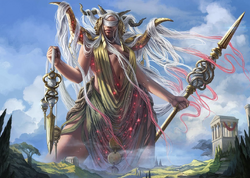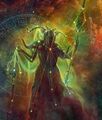Klothys
| Klothys | |
|---|---|
| God of Fate and Destiny | |
| Information | |
| Colors |
|
| Species | God |
| Birth, Life & Death | |
| Birthplace | Theros |
| Family | |
| Children | Calix (creation) |

Klothys (/kloʊθɪs; KLOH-thiss[1]) is the god of fate and destiny on the plane of Theros. She is one of the oldest deities on Theros, alongside Kruphix, and embodies the cosmic order that governs all things. Klothys ensures that the natural balance of the universe remains intact, carefully maintaining the threads of destiny so they are not unraveled by the ambitions of mortals or gods. After spending long ages in the Underworld guarding the imprisoned titans, she has recently returned to the mortal realm to address the widespread disruption caused by the god Xenagos, Heliod, and others who defied the natural order. Her goal is to restore the proper flow of fate, even if doing so causes upheaval among mortals and divine beings alike.
Description
Klothys typically appears as a woman with six curling horns and an impossibly long mane of pale hair that drapes over her eyes and winds around her horns. She carries a distaff tipped like a spear, entwined with strands of her hair, which represent the threads of fate. In her other hand, she holds a spindle used to spin these threads into destiny. Her eyes are usually hidden beneath her hair, symbolizing the impartial and blind nature of fate. Her thumb is tipped with a sharp golden nail used to sever the threads of life and destiny when necessary.
Influence and goals
Klothys is the embodiment and enforcer of destiny, ensuring that the natural order is preserved. While she largely remained forgotten by mortals during her time in the Underworld, her recent return is driven by frustration with the chaotic state of Theros. She seeks to undo the damage caused by gods like Heliod and Xenagos, as well as mortals whose actions have threatened reality itself. Klothys intends to humble the proud and defiant, restoring the status quo of cosmic balance even if this leads to widespread social and mortal consequences.
Divine relationships
Klothys views many gods with disdain, especially those she believes contributed to the upheaval of the natural order. She holds particular contempt for Heliod and his champions, often acting to teach them humility. She also clashes with gods associated with progress and change, such as Ephara, Iroas, and Karametra, seeing their influence as potentially disruptive to fate's careful weave.
In contrast, Klothys respects deities whose interests balance creation and destruction, including Thassa, Purphoros, and Nylea. She shares a deep mutual respect with Kruphix, another ancient god who recalls Theros's earliest days. Her relationship with Erebos and Athreos is more complicated; long years in the Underworld have shown Erebos's arrogance, though some respect remains. Her return from the Underworld has blurred the boundaries between realms, drawing horrors into the mortal world and angering Athreos.
Worship
Klothys does not require or seek mortal worship to sustain her power and has been largely obscure throughout most of human history. Mortals are relevant to her only insofar as their actions have tangled the threads of destiny. Her followers claim to see strands of her hair woven into all things, granting insight into cosmic truths and the way the future should unfold.
History
Origin
Klothys, along with Kruphix, is one of Theros's original gods[2][3], believed to have come into existence during the plane's earliest days. She is the personification of destiny and order, charged with overseeing the natural balance of the cosmos and making sure all things remain in their proper place.
The binding of the titans
Long ago, the titans had been sealed away in the Underworld by the combined might of the gods, and it was Klothys who volunteered to serve as their eternal jailer.[4] While Erebos ruled his realm beyond death, Klothys acted as an eternal seal to ensure the titans remained imprisoned.
Return to the mortal world
The aftermath of Xenagos' ascension to godhood, his death, and the death of Elspeth had revealed a disturbing reality: the gods were replaceable. As war broke out among the gods themselves, Erebos was consumed by his hatred of Heliod, and so Erebos began to lose control of the souls of his realm.
When countless souls dared defy fate to reverse their deaths, Klothys was livid. In reaction to all those who sought to reverse their deaths, Klothys dispatched numerous Agents of Fate to ensure they did not succeed. These Agents wielded Klothys's thread in pursuit of their goals. To properly deal with the soul of the Planeswalker Elspeth Tirel, a special agent would be needed. For this task, Klothys created Calix. As the God of Destiny's greatest masterpiece, Calix was solely created to carry out the will of Klothys.[4]
Background
The Fates were earlier depicted in the Theros block on Triad of Fates and Fate Unraveler. One of them was named Andrasteia.[5] Although she and her sisters controlled many things in the destinies of all in Theros — even at times the gods themselves — there were rules that should not be bent, and a few that must never, ever be broken. There are also fate weavers, such as Tymna, humans who have learned the magic of the Fates and can manipulate the threads for their machinations.
Inspiration
The name and character of Klothys are inspired by Clotho, one of the Moirai or Fates, Greek mythological incarnations of destiny; Clotho spun the threads of destiny, while Lachesis measured, and Atropos cut. Klothys also seems to take aspects of Persephone, namely being a female deity confined to the underworld, and Hecate, a chthonic triple goddess.
Klothys may also be based on Ananke, the primordial goddess of inevitability and fate, even holding a spindle, and wife of Chronus, primordial of time (not to be confused with Cronos the titan).
Klothys's design also seems to be partially based on Lady Justice or Iustitia as the Roman blindfolded goddess, whose Greek equivalent is Dike. The role of guardian in the Underworld is inspired by Campe, a female monster guard in Tartarus.
Gallery
In-game references
- Represented in:
- Associated cards:
- Depicted in:
- Quoted or referred to:
References
- ↑ The Vorthos Cast (February 10, 2020). "98 - Beyond Death with James Wyatt". Soundcloud.
- ↑ The Vorthos Cast (February 10, 2020). "This week we have special guest James Wyatt from Wizards of the Coast on to talk about Theros: Beyond Death.". The Vorthos Cast.
- ↑ Wizards RPG Team (2020), D&D Mythic Odysseys of Theros, Wizards of the Coast
- ↑ a b Wizards of the Coast (January 10, 2020). "Theros Beyond Death Story Summary". magicthegathering.com. Wizards of the Coast.
- ↑ Clayton Kroh (February 05, 2014). "Emonberry Red". magicthegathering.com. Wizards of the Coast.

